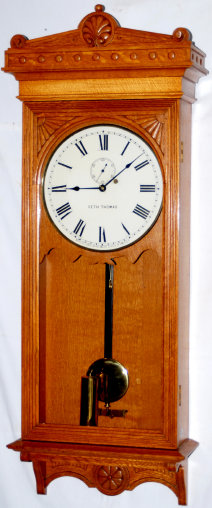
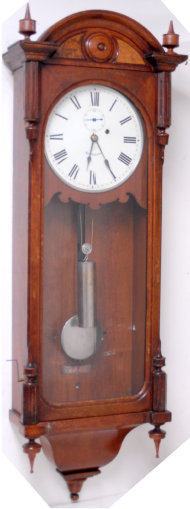
73. $1100
“Welch, Spring & Co., Bristol, Conn.”, No. 2 Calendar, ca
1878. There is a two weight time only movement in the top part of this double dial calendar clock. In the bottom is a B. B. Lewis
mechanism regulating the month and date. In the center of the upper dial there is a hand that gives the days of the week. The rosewood
veneered case is 36 inches tall, has door latches on both doors, original glasses, good veneer that is clean and polished, but there
will be some small veneer nicks on the rounded bezels. The imperfections are hard to see unless you inspect closely. Top dial has
been repainted, bottom appears to be original but with some discoloration. I believe all 5 hands are original, same with the pendulum
bob and other parts of the clock. The two labels are pretty good considering they are 150 years old. The 8 day time only movement
is powered by two round iron weights which we also believe are original to the clock, and it is running as intended. Ly-Welch, page
72.
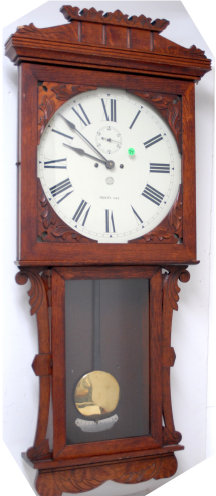
74. $500
New Haven Clock Co. large wall clock “Commodore”, with a 30 day
time movement, ca 1883. The large oak case is as nice as any oak clock I have seen. Not just the unusual case style but the graining
and richness of the wood make it look more like walnut. There are some very nice carvings on the door over the dial and some good
jig saw work from top to bottom of the large 46 ½ inch high case. Other than polish and cleaning the only change made to the clock
was to repaint the dial. It was painted by The Dial House and has the proper logo and is signed, “Thirty Day”. The very large dial
pan is 16.5” square. Both glasses are old, original, hard to tell. The repainted dial, hands, polished brass bob, wood stick, and
signed beat scale, are all original. As with all of New Haven’s 30 day movements, this one is strong running and keeps accurate time.
Ly-New Haven #556. $650-$900.
72. $750
Seth Thomas Clock Co. “Regulator No. 6”, ca 1885. This valuable
clock case has not been cleaned and restored. That does not mean that it is in bad condition, I suspect it is because everything was
pretty nice and he chose to leave it that way. All the internal parts, such as the 8 day time only movement, pendulum, weight, beat
scale, practically a complete black label, painted dial, and the hands, all appear original to the case. The pendulum, weight, beat
scale, dial ring, and even all the screw heads inside the case are nickeled. The dial is signed and the paint is original. None of
the nickel parts have been polished. The door glass has been replaced and Bubba appears to have struggled nailing the wood strips
in place. There are two key door locks, four perfect and correct finials as nice as any Seth Thomas made. If I were to keep this clock
I would lightly clean and polish the nice case. Every time I get a No. 6 in here I want to keep it. Not only are they very attractive
but they use the same movement found in the Seth Thomas No. 2 Regulators and that means they never wear out, they just keep on running.
If you follow our auctions you know in the past we have sold Regulator No. 6’s in several recent auctions, fetching anywhere between
$5000 and $10,000. Ly-Seth Thomas, page 284. $1000-$1500.
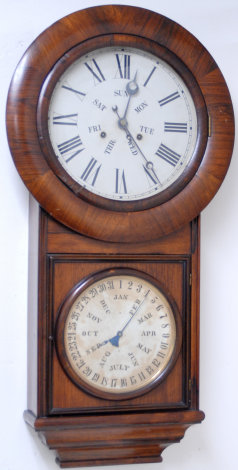
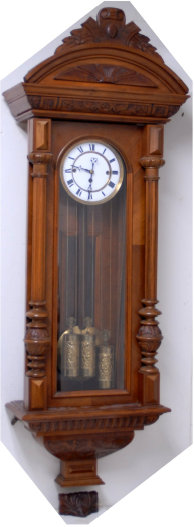
75. $400
Three Weight, Grand Sonnerie, Vienna Regulator, ca 1875. Brass
movement is signed by the maker’s trademark insignia, “CF”, or “GF”, or something else, it is hard to decrypt. Double
coil gongs on the back of the movement that sound the quarters and hours. Called a “Blind Man’s Clock”, because when it strikes quarter
hours and hours during the night you know what time it is. It strikes one time 15 minutes after the hour, then strikes the number
of the last hour. At 30 minutes past the hour it strikes two times on one gong, and the number of the last hour on the other gong,
etc. Near perfect two piece porcelain dial and a great pair of Vienna hands. Polished brass pendulum bob, porcelain beat scale, three
matching brass weights, three matching brass pulleys, and a winding crank. The 54 inch light to medium walnut case is very nice, full
grooved columns on the door, nice carvings below the columns, carvings all over the top piece, carvings on the base and the very bottom
carved piece that I failed to glue in place for the picture, but show it at the bottom. I believe the top is original to the case
but new pegs and peg holes have been made. The walnut finish has been rubbed, now with a slick furniture like finish. Picture frame
on the backboard with a darker walnut wood insert. There are three good glasses, wall levelers, and a door latch. $500-$750.
71. $500
Seth Thomas Clock Co. “Regulator No. 30”, ca 1975. Golden oak
case is a reproduction and copied from an original Seth Thomas clock. It is clean and polished as you would expect. It is 49” long,
complete, and has no damaged parts. It came to us from the collector’s wall where it had been providing excellent timekeeping and
personal enjoyment for many years. The painted dial is near perfect, and has three correct and original hands. The dial ring is polished,
so is the weight, pendulum bob, and beat scale. The wood stick and all other accessories including the door locks, movement mounts,
and the 8 day movement are all replicas of Seth Thomas stock. A very nice reproduction. Ly-Seth Thomas #306. $750-$1000.

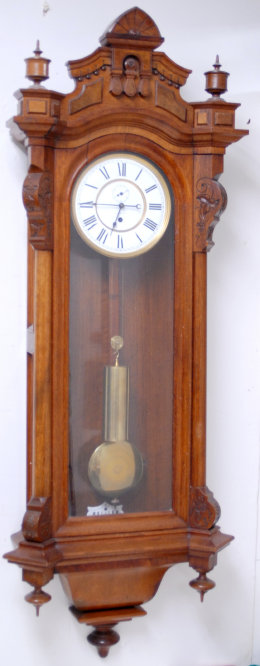
76. $8000
Seth Thomas Clock Co. “Regulator No. 5”, ca 1885. This is probably
the most difficult of all Seth Thomas regulators to find. I have only known of two others selling. We like this type Seth Thomas clock
because it has a very soft tick and is time only. The case is walnut standing 50” tall, has all the finials and other wood parts,
is very clean and polished and has a good amount of carvings. There is burl walnut trim on the case in several places. The entire
case is as slick as a ribbon and has a wonderful finish all over. I am calling the case walnut because of the burl but I guess it
could be flame mahogany. The case is not very dark and resembles mahogany more than walnut. The only fault I find with this clock
is a small veneer chip on the base and some loose veneer that resembles where you may have damaged it slightly at some time many years
ago. It is worn and has rub marks but it is perfectly fine with us just the way it is, being original, so I did not bother to have
any unneeded repairs made. The 8 day time only weight driven movement is high quality with a solid back plate, cut pinions, maintaining
power and a second’s hand. The case lock, brass pendulum and wood stick, weight and pulley, and the three hands, all appear to be
original Seth Thomas stock. The weight, pulley and dial rings are brass and the beat scale is porcelain. The two piece porcelain dial
is perfect, is signed, and has a seconds dial. There is one door lock on the side and two glasses on each side. Ly-Seth Thomas, page
283. $10,000-$15,000.

77. $500
Seth Thomas Clock Co. “Office Calendar No. 1”, ca 1875, per the
catalogs. The label on the wood panel that was on the back of the door was replaced with glass bearing a previous owners name and
town. The rosewood veneer grain is just outstanding, flowing in numerous directions and matched skillfully by the craftsmen who assembled
the case. It surely has been cleaned and polished some especially on the door, but there is smoke on the sides of the case or in the
crevices on the outside. I know it has not been refinished, scrubbed with a brush, etc. for it is just too nice. There are no veneer
problems that jump out at you. The painted dials are original, top has been repainted, bottom is original. There are some spots on
the bottom dial where the paint has chipped. The hands are correct, so are the weight, pendulum bob, and special pendulum hanger.
The calendar roller papers are dark, and that is the only hint of smoke on the front. I still do not think they are dark from smoke,
but only age. The time movement runs 8 days and was in good running condition when we took it off the collector’s wall. Gracious,
the clock is at least 140 years old, a part of America’s early clock history and not long ago was selling near the $5000 range. The
8 day movement is time only and original to the case, and the calendar parts are all original to the clock. Ly-Calendar, pages 246-247;
Ly-Seth Thomas, page 90. The clock books at $5000 and more, we have been selling them for $3000-$4000 not long ago. It sure is tempting
to keep this clock. $750-$1000.

78. $2000
Ithaca Calendar Clock Co. “No. 2 Regulator, Or Hanging Bank Clock”,
ca 1874. The early regulators “O”, “1”, and “2”, were very similar in case design but the movements were different. The No. 2 case
is made of walnut and is 48” high, glass port on the bottom, large finial on top. This clock is not perfect by any means but for its
age it is still ticking. If the paper dials are not original they are missing a good chance. The bottom paper dial has a tear
repair and slightly darkened. Both dials are original and for their age are very nice. The time dial is not as nice as the calendar
dial, lots of tares and repairs but the consignor chose to have original dials rather than new white dials. The upper movement is
8 day, two long wafer type weights. The perpetual calendar movement was invented by Cousin Henry Horton, the founder of the Ithaca
Calendar Clock Co. One door lock operated with the winding key. Present are all the accessory parts, the two original weights, brass
pendulum bob, three hands, calendar rollers, ands both paper dials. Ly-Calendar #294. $3500-$4000.
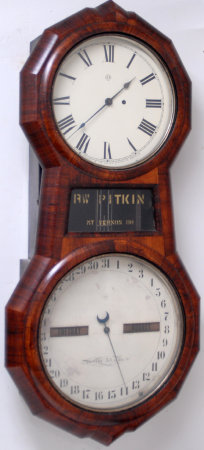
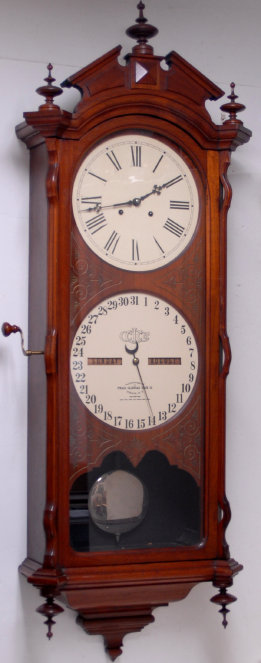
79. $1000
Ithaca Calendar Clock Co. “No. 2 Bank”, ca 1880. Double
dial calendar clock made of walnut, standing 61” high, and was restored by Joel Warren or some other good cabinetmaker some time ago.
We believe there are a couple of new finials, copied from originals, and other new pieces, especially the back board, the base, and
some internal parts. They were so well constructed they are not evident. He glued, straightened, cleaned, and polished the case, making
it a clock anyone could be proud to own. The clock is as prestigious as the No. 1 Regulator, but did not have a sweep second hand.
The two dials are new paper. Calendar rollers are old. Correct nickel pendulum bob and hands. The base screws on and off easily, the
originals would slide off. Originally, the clock could be ordered and used as a shelf or wall clock. This is a very nice clock but
one that should be inspected hands on by any bidders. I will email digital photos that can be enlarged but we recommend a personal
inspection, if possible. I could have a repairperson check things for you if you are a serious bidder. We would not like to have the
clock returned because of some piece of new wood that we could not detect. If you are that fastidious, we would rather you not bid
on this clock. Unfortunately, our clocks are not perfect. Ly-Calendar, pages 128-129. $1500-$3000.
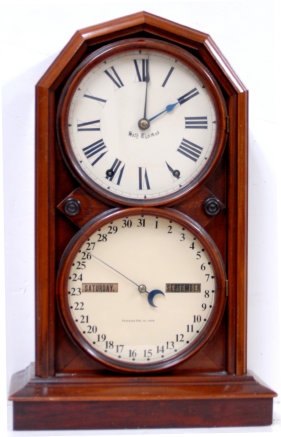
80. $450
Seth Thomas Clock Co. “Parlor Calendar No. 5”, ca 1886. It is
extremely clean and polished walnut case, standing 20” high. There is a key lock on the side, two original glasses, pendulum, and
winding key. Two correct hands over the repainted original zinc time dial, but I do not believe the calendar hand is original. The
calendar dial is also repainted and is a slightly darker shade than the time dial. You can read the ST logo, patent dates, and other
inscriptions on the dials, they are not dirty. Large 8 day brass movement is signed, clean, and running. It strikes hours on a shining
brass bell. On the door, inside, is a paper label, the same place I have always seen the labels on the No. 5 double dials and there
is a complete dial behind the calendar movement with instructions, not to oil. Ly-Calendar #632. $500-$750.